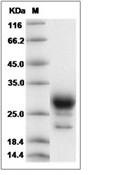Shopping Cart
- Remove All
 Your shopping cart is currently empty
Your shopping cart is currently empty

Prostaglandin D2 Synthase Protein, Human, Recombinant (His) is expressed in HEK293 mammalian cells with His tag. The predicted molecular weight is 20.1 kDa and the accession number is P41222.

| Pack Size | Price | Availability | Quantity |
|---|---|---|---|
| 100 μg | $451 | In Stock | |
| 200 μg | $771 | 7-10 days | |
| 500 μg | $1,560 | 7-10 days |
| Biological Activity | Activity testing is in progress. It is theoretically active, but we cannot guarantee it. If you require protein activity, we recommend choosing the eukaryotic expression version first. |
| Description | Prostaglandin D2 Synthase Protein, Human, Recombinant (His) is expressed in HEK293 mammalian cells with His tag. The predicted molecular weight is 20.1 kDa and the accession number is P41222. |
| Species | Human |
| Expression System | HEK293 Cells |
| Tag | C-His |
| Accession Number | P41222 |
| Synonyms | PTGDS,prostaglandin D2 synthase 21kDa (brain),PGDS2,PGDS,PGD2,PDS,L-PGDS,LPGDS |
| Construction | A DNA sequence encoding the human PTGDS (P41222) (Met1-Gln190) was expressed with a polyhistidine tag at the C-terminus. Predicted N terminal: Ala 23 |
| Protein Purity | ≥ 80 % as determined by SDS-PAGE. ≥ 90 % as determined by SEC-HPLC.  |
| Molecular Weight | 20.1 kDa (predicted); 28 kDa (reducing conditions) |
| Endotoxin | < 1.0 EU/μg of the protein as determined by the LAL method. |
| Formulation | Lyophilized from a solution filtered through a 0.22 μm filter, containing PBS, pH 7.4. Typically, a mixture containing 5% to 8% trehalose, mannitol, and 0.01% Tween 80 is incorporated as a protective agent before lyophilization. |
| Reconstitution | A Certificate of Analysis (CoA) containing reconstitution instructions is included with the products. Please refer to the CoA for detailed information. |
| Stability & Storage | It is recommended to store recombinant proteins at -20°C to -80°C for future use. Lyophilized powders can be stably stored for over 12 months, while liquid products can be stored for 6-12 months at -80°C. For reconstituted protein solutions, the solution can be stored at -20°C to -80°C for at least 3 months. Please avoid multiple freeze-thaw cycles and store products in aliquots. |
| Shipping | In general, Lyophilized powders are shipping with blue ice. |
| Research Background | PTGDS, also known as L-PGDS, belongs to the calycin superfamily, lipocalin family. Lipocalins share limited regions of sequence homology and a common tertiary structure architecture. They transport small hydrophobic molecules such as steroids, bilins, retinoids, and lipids. PTGDS is a glutathione-independent prostaglandin D synthase that catalyzes the conversion of PGH2 to PGD2. It is involved in smooth muscle contraction/relaxation and a variety of central nervous system functions. PTGDS may have an anti-apoptotic role in oligodendrocytes. It binds small non-substrate lipophilic molecules, including biliverdin, bilirubin, retinal, retinoic acid and thyroid hormone, and may act as a scavenger for harmful hydrophopic molecules and as a secretory retinoid and thyroid hormone transporter. It is likely to play important roles in both maturation and maintenance of the central nervous system and male reproductive system. |

Copyright © 2015-2025 TargetMol Chemicals Inc. All Rights Reserved.